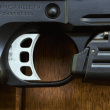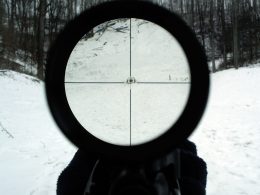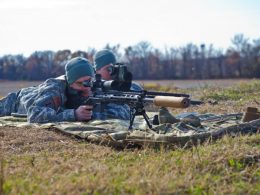For a sniper to effectively approach and strike a target, he must be practically invisible throughout the hunt. Assessing the proficiency of a sniper’s concealment requires him to advance within 200 meters of a trained observer and fire two shots before withdrawing undetected. Part of the sniper’s job is being highly competent in obscurity while moving around and towards a vigilant target.
Definitions
Understanding cover, concealment, and camouflage is paramount for a sniper to execute his mission successfully. There are notable differences between these terms.
Cover refers to protecting the sniper from small arms fire, which can be in the form of hiding under natural elements like a rock or taking cover behind a manmade object like a military tank. Cover does not mean the sniper is hidden; it is simply a form of defense from the onslaught of fire. It does however prevent the sniper from completing his mission, so he must draw on his sniping skills to detect the position of the enemy by coming out from cover, using concealment.
Concealment is how the sniper can blend into his surrounding using natural or artificial materials as camouflage such as bushes, grass, burlap or camouflage nets. Camouflage is the technique used for concealment. Using 60-70 percent of natural materials native to the surroundings with 30-40 percent made up of mock camouflage fabric. This is more effective than solely using manmade materials, because at close observation it can negate effective concealment. Once camouflaged, the sniper is observed using target indicators.
Target Indicators
Target indicators refer to elements that can give the sniper’s position away. It’s important for a sniper to know these indicators so he can avoid them to remain hidden but also to use them in detecting the enemy. The four target indicators are: olfactory, tactile, auditory, and visual.
Olfactory is being able to smell someone’s presence, tactile indicators enable the enemy to physically touch something that exposes the sniper or vice-a-versa, auditory is hearing something that reveals someone’s location and visual indicators gives position away through sight.
Target indicators: Tactile (Touch)
These are clues that expose the presence of a sniper or his hiding position. Leaving sharp, obvious edges from cut branches to create a hiding site, clearing a path or leaving any debris nearby are indicators that someone is in the area. If an enemy picks up on any of these clues, they will scrutinize the surrounding until the sniper is captured. Employing booby traps is mostly counter-productive when up against enemies who are trained to look out for these devices.
Target indicators: Olfactory (Smell)
Giving off any smell can be a fatal error especially if dogs are used to trace the scent. Making use of any cleaning substances whether its body lotion or deodorant, or solvents for the weapon, as well as cooking or smoking, or using a makeshift latrine are all dead giveaways. Essentially, snipers should use food and weapons solvents that are used by the enemy to avoid any distinct smells that will attract attention.
Target indicators: Auditory (Hear)
This is an important one especially in darkness, fog or mist. Moving the body, the weapon or making any sound can be easily detected under these conditions. Snipers must pay careful attention to the natural sounds in the area while be mindful of what noises they give off whether walking or sitting. Wildlife also respond to movement and they can give the sniper’s position away if he makes any sudden, unnatural movement or noise. Sudden quietness from wildlife who sense the sniper’s presence can also be clues used by the enemy to detect human company in the area.
Target indicators: Visual (See)
The following visual indicators are the most likely signs that will give a sniper’s position away:
Visual: Siting
These are factors that make the sniper’s location obvious such as using camouflage that doesn’t blend in with the surroundings, or mounds created from constructing a hide site. And, if a spot seems perfect for a sniper to hide then it can also be the most obvious.
Visual: Shape
Objects are recognized by shape and when it contradicts background, it gives the sniper away. Specifically, the human body and sniping equipment can be detected if not well hidden. Manmade objects have geometric shapes, but nature doesn’t. Shapes can result in the following visual indicators exposing a sniper’s position:
Visual: Shadows and Silhouettes
Shadows can be detrimental against excessive light and extreme contrasts can reveal the sniper’s location. Although it can sometimes work in the sniper’s favor, utmost care must be taken not to create unnatural shadows, shapes or silhouettes that are easily detected by the enemy’s eye.
Visual: Surfaces and Spacing
Surfaces that shine or have contrasting textures to the surroundings are other indicators that can reveal where the sniper is hidden. This includes surfaces that give off shadows. Spacing is something that affects a team of snipers more than individuals who are working alone. If a team forms a noticeable pattern, the enemy may pick up on this exposing the whole group.
Visual: Color
Differences or changes in color is another indicator that can reveal where the sniper is hiding. If the color does not naturally blend in is a sure clue to the enemy. Avoid using black or any color that will stand out against the natural environment.
Visual: Movement
Movement is undeniable proof that a sniper is in the area. Even if no other target indicators are present, any slight movement of the sniper or movement by wildlife in response to the sniper’s presence will catch the enemy’s eye.
Camouflage
Camouflage discipline and construction are key factors to effective concealment. Discipline requires the sniper to do what’s required to maintain the efficacy of the camouflage, so it retains a natural fusion with the surroundings. The construction references hiding, disguising and blending.
Hiding conceals the sniper from any detection by the enemy but the sniper must be able to the see the enemy without the enemy noticing the sniper. Employing disguises deceives the enemy into making false assumptions about the sniper’s location. Blending is the art of melding into the surroundings by using the right, bland colors without recognizable patterns. Weather conditions and the terrain must also always be considered when using camouflage techniques.
Natural camouflage materials such as leaves, natural dyes, and grass are important to properly conceal the sniper and his weapon from any enemy detection. While natural camouflage is ideal, artificial materials can help to cover up gaps and any parts of the skin. Using burlap, ghillie suits and camo clothing are useful if it doesn’t give away the shape of the human body hiding away.
Conclusion
Remaining undetected from the start till the completion of the mission is the sniper’s first and foremost concern. Be mindful of every possible target indicator to avoid becoming the enemy’s target. Using selected techniques that match the surroundings are paramount to a sniper’s survival.









